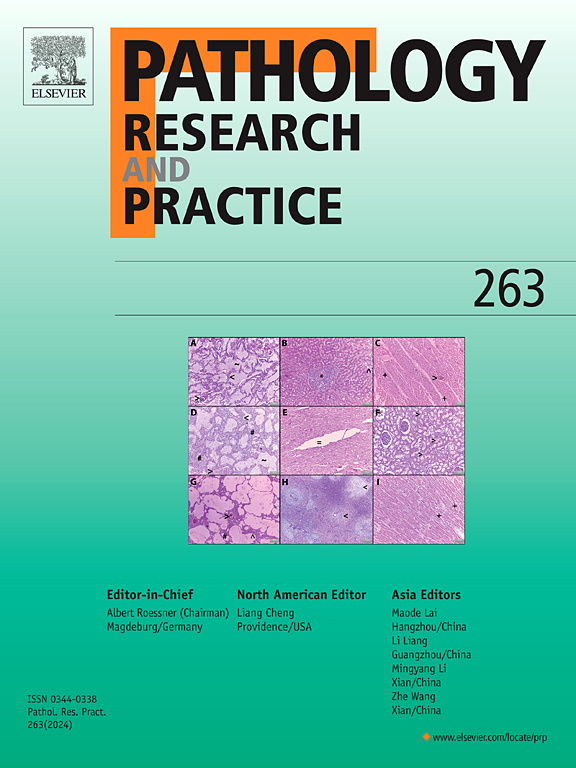基于下一代测序技术的血管球瘤突变景观及基因组图谱的临床应用
IF 3.2
4区 医学
Q2 PATHOLOGY
引用次数: 0
摘要
血管球瘤(Glomus tumor, GT)是一种罕见的肿瘤,其生物学行为和分子遗传学特征尚未完全了解。本研究旨在利用新一代测序技术(NGS)全面检测GT的基因突变,并将这些发现与临床和病理特征相关联,为GT的发病机制和精确诊断提供新的见解。在44个GT样本中共鉴定出171个体细胞单核苷酸变异(snv),其中包括114个非synonymous_substitution、36个Intronic、11个FrameShift_Duplication、4个FrameShift_Deletion、3个Splicing和3个Nonsense_Mutation事件。最常见的突变类型是G-A转变。常见的突变基因包括BCL2L11、MUC16、KRAS和BCR。大多数拷贝数变异(CNVs)为损失;仅在CDK4(4/44, 9.1 %)和CDK6(3/44, 6.8 %)中观察到获益,并且仅限于良性和非典型GT。高TMB与KRAS, TP53突变之间存在显著相关性。途径富集分析显示KRAS突变在远端GT中占主导地位,而BRAF V600E突变在近端位置更为普遍。非典型/恶性GTs可能与上皮-间质转化途径有关。51个GTs的肿瘤微环境基因分型表明男性患者更容易发生冷肿瘤(P = 0.0686)。本研究首次利用NGS技术对GT的分子遗传特征进行了全面的探索,为GT的基因突变格局提供了初步的概述。本文章由计算机程序翻译,如有差异,请以英文原文为准。
Mutational landscape of glomus tumor and clinical application of genomic profiling based on next-generation sequencing technology
Glomus tumor (GT) is a rare tumor with incompletely understood biological behavior and molecular genetic characteristics. This study aimed to comprehensively detect genetic mutations in GT using next-generation sequencing (NGS) and correlate these findings with clinical and pathological features to provide new insights into the pathogenesis and precision diagnosis of GT. A total of 171 somatic single nucleotide variants (SNVs) were identified in 44 GT samples, including 114 nonSynonymous_Substitution, 36 Intronic, 11 FrameShift_Duplication, 4 FrameShift_Deletion, 3 Splicing, and 3 Nonsense_Mutation events. The most frequent mutation type was G-A transition. Commonly mutated genes included BCL2L11, MUC16, KRAS, and BCR. Most copy number variations (CNVs) were losses; gains were observed only in CDK4 (4/44, 9.1 %) and CDK6 (3/44, 6.8 %) and were limited to benign and atypical GT. There is a significant correlation between high TMB and KRAS, TP53 mutations. Pathway enrichment analysis revealed KRAS mutations were predominant in distal GT, while BRAF V600E mutations were more prevalent in proximal locations. Atypical/malignant GTs may be associated with the epithelial-mesenchymal transition pathway. Tumor microenvironment gene typing in 51 GTs suggested a tendency for cold tumors to occur more frequently in male patients (P = 0.0686). This study represents the first comprehensive exploration of the molecular genetic characteristics of GT using NGS technology, which provides an initial overview of the genetic mutation landscape in GT.
求助全文
通过发布文献求助,成功后即可免费获取论文全文。
去求助
来源期刊
CiteScore
5.00
自引率
3.60%
发文量
405
审稿时长
24 days
期刊介绍:
Pathology, Research and Practice provides accessible coverage of the most recent developments across the entire field of pathology: Reviews focus on recent progress in pathology, while Comments look at interesting current problems and at hypotheses for future developments in pathology. Original Papers present novel findings on all aspects of general, anatomic and molecular pathology. Rapid Communications inform readers on preliminary findings that may be relevant for further studies and need to be communicated quickly. Teaching Cases look at new aspects or special diagnostic problems of diseases and at case reports relevant for the pathologist''s practice.

 求助内容:
求助内容: 应助结果提醒方式:
应助结果提醒方式:


